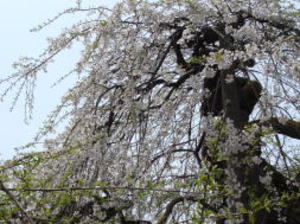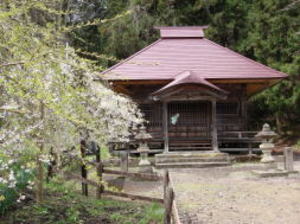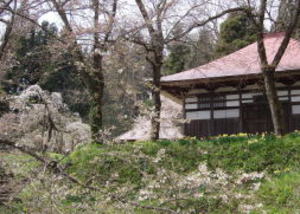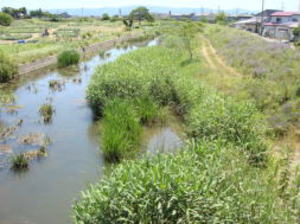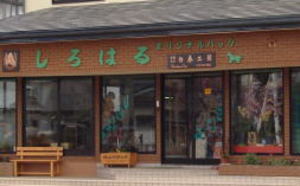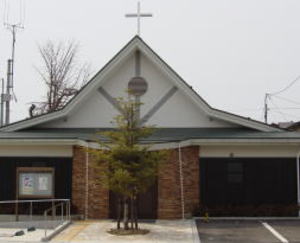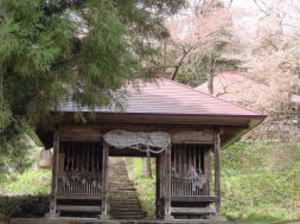From the front of Suwa shrine to the south, and crossed the railroad crossing
of JR Tadami
Line from front of Bange Kosei Hospital, about 2km. It is on the tip of
the alluvial fan
plateau made by the orogenic activity of the West Edge fault Zone of the
Aizu basin outside
Funakubo village. Get full view the Aizu Basin and Mount Bandai, it is
a good vantage
point.
In Heisei 7 year(1995 year), it opened. This is a memorial facilities to
the honorary
townspeople of from Todera in Aizu Bange town, and the Showa Great Enka singer, Hachiro
Kasuga. The whole was a memorial park, and in front of the memorial hall, it was
sung by a
big hit song the "Wakare-no-ipponsugi" and "Stone Jizo". Jizo is a "north-facing Jizo", and as
a "Koyasu Jizo", it has gathered the faith of neighboring inhabitants. When you stand in
front of the memorial monument, you can hear the song of "Wakare-no-ipponsugi".
In the museum, photo of to think
of Hachiro Kasuga, stage costumes and his song
records,
Hachiro
Kasuga Memorial Park & Memories Hall
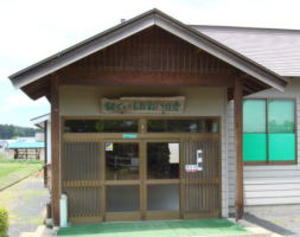
Hachiman Shrine" from "Iwa-Shimizu Hachiman Shrine" in
Kyoto. And Tengi 5 year (1057 year) Yoshiie (another name
Hachiman Taro Yoshiie) is battle formation to the dense reed of the place
of the East 3km, white flag eight of the symbol of
Genji, and "Hachiman Omikami" was enshrined. At the end of the
fierce battle with the army of Abe-no-Sadato of this land, it
seems to have won a big victory by clean sweep the Abe's army. It is so. This whole region is a historic battlefield of the role of
the Former 9 years war. Look at the turbulence in the rows of wild geese
flying over the reeds field, Yoshiie who knew that the
enemy soldiers were lurking, had run a preemptive strike. The stage of
the anecdote of "Reed field's flight of wild geese" is here.
This win in the Former 9 years war, it was the starting points for the
victory of the expedition.
According to the Aizu-Nenpyo(chronology), it is said that, Jisho 2 year
(1178 year),"Shirohata (white flag) Gongen" praying for
the coming of a deity was put on the historical sites of the battle formation
of the Yoshiie. It was renamed "Shirohata Hachiman
Shrine" later. Enshrined deity is the God of the War by Hondawake-no-mikoto ( Emperor
Ojin). The Feast day is on September 1.
The back of the shrine, the old Tsurunuma-gawa river (mainstream of the
old Aga-kawa river) flows, there is a boat wharf, a
big tree of the pine of the connecting boat which called "O-ise-no-matsu(the Pine of Ise)" it was until
the Showa 30 year (1955
year). It is to say that it cut down at the time of agricultural field improvement,
although it was a old pine tree which says that
tree age exceeded 1000 years old. The time of Shikinen-Sengu of Ise-Jingu,
granted material was carried by boat, it is said that
the name was attached because it carried here and the boat was connected to the pine. The bestowal material of Ise Jingu is
said to have been used to rebuild Hirose shrine. The vacant lot between the shrine and the Shimo-mandokoro village was the
ruins of the village in the middle ages, and the old pots and plates of celadon had been excavated before. A full-fledged
investigation has not been done yet, and an excavation and an academic
investigation of the whole place of the hereafter will
be waited for. That said in the public works, the Cherry Tree roadside
in front of the Bange station, Saimyo-ji across and pine
of the connecting boat of Tsurununa-gawa river, stone of connecting boat
of Aozu, and such as the pine of Ise here, that the
history and heritage of the town were destroyed without any record or
trace. What should we explain to our ancestors?
Rather than say, did nothing happen to the business people involved in cutting the pine of Ise? "divine punishment" of
Amaterasu-o-mikami and or ..., Anxious ~~!
Want to
think anew of the word "learn a lesson from the past" and
"cultural heritage of the town".
(Welcome map, Aizu Bange town North-west area map)
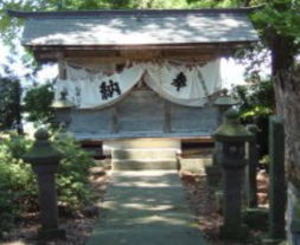
"Yachiyo-basi (bridge)" over the Tsurunuma-gawa river in Kitakata-kaido road, and the
place name of the residential area between the downstream "Saiwai-bashi(bridge)"
is called
"Shiju-koku (Forty-koku)". The origin of this place name was time of the water traffic was
active, from Echigo (Niigata prefecture), the boat load that has climbed
up the Aga-river and
after unloading in the Aozu, Shiju-koku-boat laden with luggage to the direction of Bange
and Wakamatsu, a wharf which had been in and out was near the Saiwai-bashi
bridge. By
the time I was in elementary school, the traces near the "Saiwai-bashi
bridge" (photo) were
still left. Since river was already shallow at that time, it was not thought
that the boat had
At the same time as the Christianity prohibition decree, Aizu Bange believers will be converted and their believers to come to an
end. Boshin soon after the war, missionary work will be resumed.Missionary work record in Aizu Bange town is, from Meiji 35
year (1902 year, the UK-Japan Alliance concluded, and when public opinion begins toward the Russa-Japan War). The present
building was rebuilt in 2006 year, the place where the late Mr.Yuichi Usuki's house. Until about Showa 40 year (1965 year), the
worship was held in the room of Mr.Yuichi Usuki's house. Mr.Yuichi Usuki was open an English cram school here. And I went to
the English cram school here as a measure to take the examination of high
schools during the Showa 36,7 year (1961,2 year, the
time of pollution problem occurred) of old Bange 1st junior high school
(current Bange junior high school).
Maybe this is the start of a cram school in Aizu Bange
town? The prayer room was the cram school room. Sometimes, Pastor
Armin Klela of Takada Church (Takada discrict, Aizu Misato-machi) came,
and he taught me a native pronunciation.
In the Christmas season, the English hymn book was a
textbook.
When I was active, conversation with U.S. soldiers, and when I went to
EU Germany on a business trip abroad, I did not have a
hard time could talk with Germany people and Italian people.
From U.S soldiers was said to me "Your words seems hear to rain on pearls! (Kings English) ".
Even now, I am thankful to Mr.Usuki.
(Welcome map, Aizu Bange town center area map)
It is officially called the United Church of Christ in Japan, Bange Church
and is located
opposite the Bange Post office.
Christianity came in Aizu, Tensho 18 years (1590 year, when Hideyoshi Toyotomi
was unified
nationwide) when Mr.Ujisato Gamo joined as the Lord of Aizu, because there
were a lot of
enthusiastic believers in the subordinate, the Christian faith spread
throughout Aizu. It is said
that there were three churches in Bange at that time, but ther dose not
supporting things.
Is the "Maria Kannon" of Hirose Shrine a remnant of this time?
Keicho 16 year (1612 year) it
seems that missionary work was being performed in various parts of Aizu
until the Christianity
Prohibition decree was promulgation.
JR East
Japan Tadami line Aizu-Bange Station
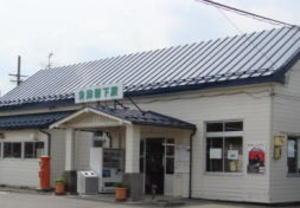
overwhelming presence, and I feel like being in the same time and space
as the painting. At the Museum of Art, there are
occasional works exhibitions of elementary school, junior high school and high school students in Aizu Bange, and the
exhibition of artists related to Aizu Bange town is also held, and it
plays a role as an art salon in Aizu Bange town. The artist
was born in Taisho 14 year (1925 year), Kanagami district, Aizu Bange-town,
Kawanuma-county, until moved to Tokyo, he was
a teacher of art at the old Kanagami junior high school (Kanagami community center), Bange 1st junior high school, and
Wakamatsu 2nd junior high school. He had received numerous awards at the Japan Art Academy exhibition.
When I was in time the art at the old Bange 1st junior high school, Mr.
Kobayashi who saw the picture of me it was drawing
the scenery from the window of the classroom, "Oh! ... it's very well-drawn!
" I remember that it was evaluated. I was a sports-
oriented, but when I was little boy I was good at drawing. Although same
lived in Ebina City, Kanagawa Prefecture, I hoped to
meet on during the lifetime and talk to he while I was drinking.
Opening Day / Every Saturday, Sunday and national holiday
Opening hours (admission until 16:00)
Admission fee / Adult 200 yen (160 yen) Children (elementary School and
below) are charged for groups of 20 people or more
Tel・FAX / 0242-84-1233
(Welcome map, Aizu Bange town center area map)
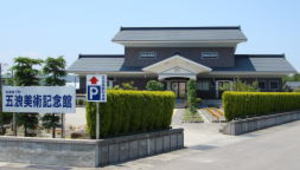
In the Temple-biography, the principal image " standing statue of
the Elaven-faced Thousand-armed Kannon " is, Daido 3 year
(808 year) in the wake of spiritual trial by Kobo-daishi Kukai, it is told
that it was carnal reality with the spirit of "One Sword
Three Rei(bow)" in the large tree of the Zelkova. In fact, I think
that it is Tokuitsu-Daishi (Bandai-machi, Yama county), not
Kukai but Enichi-ji temple.Kukai returned from Tang (To, current China) in 806 year. Around in 807
year because he was
staying in Kyushu, it is difficult to think that at that time was in Aizu
when considering the distance. It is thought that Tokuitsu
-Daishi was likely to have constructed by receiving the petition of Kukai.
Total height 8.5 m, statue height 7.4 m, a wooden
sculpture of the largest one in Japan.It's imposing appearance is considered to be one of the "Japan three
large Kannon", with
the Hase-dera temple of in Hatsuse Nara Prefecture and the statue of Hase-dera
temple in Kamakura, Kanagawa Prefecture.
It is told that the image was carved from the tree, and it is called "Tachiki-Kannon" because it is still firmly rooted to the earth,
and has collected the people's faiths from ancient times. With the Niju-hachi-Bushu (twenty-eight attendants), and the Fujin(Wi
nd-god) in the inner circle and the East-temple, and Raijin(Thander-god)
on the West-temple is arranged, the 30-body image height is a work of the
Muromachi period of
one wooden tree of Zelkova and magnolia of 157 ~ 175cm, the world of religious beauty in the esoteric style of Buddhism attracts
the hearts of people who worship in awe. In this way, the temple, which
has been accompanied by the Niju-hachi-Bushu, is only
three temples of Kyoto's Sanju-san-gen-do temple, Kiyomizu-dera temple
and Eryu-ji temple in Aizu Bange.
In the inner circle there is a "Hold Pillar", and if you hold
on to this pillar and make a wish, because it is a profit, it is "Hold
-Kannon". In addition, it is called "Korori-Kannon", from
the heart request of the elder person of the mercy of the elderly, and
many worshippers visit from the outside of the prefecture. The pillar of the right corner outside the Kannon-do is "the Hold pillar
with the outer side", and it is possible to make a wish even if it does not enter the hall.
Aizu 33 Kannon No.31 Fudasho(Pilgrimage Site).
(Welcome map, Aizu Bange town North-west area map)
"Aizu-Korori-three-Kannon" is,
(1) Todera district, Aizu Bange-machi,Kawanuma-county, Kintozan Eryu-ji temple,
"Tachiki-Kannon".
(2) Negishi district, Aizu Misato-machi,Onuma-county, Fumonzan Koan-ji temple,
"Nakada-Kannon"
Dr. Hideyo Noguchi's mother Ms Shika, was famous for her faith.
(3) Nozawa district, Nishi-Aizu-machi, Yama-county, Kongozan Nyoho-ji temple,
"Torioi-Kannon"
As a Kannon sacred sites in three temples, it is widely gathered
faith as a symbol of the Buddha capital of Aizu.
The Todera district is a temple town of Eryu-ji temple, since the Echigo-kaido
road has passed through here, shukuba (post
-station) town has flourished as well. Aizu-Kujizakko in reported, Kinmei
Emperor 9 year (540 year), a monk Seigan of the
Chinese Ryo (Liang, one's of old China) country enters Aizu, and said the thatched hut was built in Takadera mountain and
called "Takadera". However, Hoki 6 year (775 year, time of Shomu
Emperor) will abolished burnt down by a fire during war.
The Yamato government wants to strengthen the Ritsuryo system, instructed Aizu-Gunga, it is said that it was made to attack
by seduces the crowd of Tennei-ji temple (Higashiyama district, Aizu-Wakamatsu
city).
It built a cathedral at this temple to the current location, was to be
able to worship the appearance of the Thousand armed
Kannon of the principal image, in Daido 3 year (808 yer), It is said from
the revival of Tokuitsu Daishi of Enichi-ji temple
(Bandai-machi, Yama county).
In "Shin-pen-Aizu-Fudoki", it is described that there was a golden
tower in the precincts of the temple, it has been told that the
name of "Todera(tower-temple)" happened because it was able to
hope this tower from the village of the distant Bange.
In the Aizu-Shotoki, " the time of Saimei Emperor 4 year (658 year),
Renku Shonin was live in Eryu-ji temple, and large temple
edifice was construction".
And in Aizu-Kagami, Saimei Emperor 9 year (663 year), a disciple of Renku
came to the village and
built a large temple edifice in the ruins of little hermitage, the building
of the large and small of the 36 builindgs, it is said that
"Sekitozan Eryu-ji temple", and it has been told that Renku is the restorer. The war of the Hoki 6 years (775 years) is abolished
temporarily, at the Enryaku 23 year (804 year),the Kinto-zan Eryu-ji temple
the reconstruction began, and it will be rebuilt in
Daido 3 year (808 year). However in the Yowa 1st year (1181 year), this
time, will lose most of the temples and the monks, in the
attack of the Allied forces by Jyo Shiro Nagamochi of the Jingamine-jo
castle with Enichi-ji temple, but the history of the rise
and fall and the eventful has come to the present, such as being rebuilt
again in Kenkyu 1st year(1190 year) .
The Nio of
this place is a fight partner of "Nio of Sugi Yakushi"
(Welcome map Aizu Bange town North-west area map)
It is said that the name of the Itozakura is attached from the appearance that the thin branch has white flower like the thread.
It starts blooming with pale pink flowers, but it becomes white when it
is at its peak. I am worried that the tree has declined in
recent years. Please do not go into the fence and damage the roots. A
town designated natural monument.
The two cherry blossoms on both sides are other called "Aizu-shidare"
which is a unique variant in this land by the grandchild
cherry tree. On the side of Roku-jizo in front of the Yakushido, the "Yakuoji-yae(Aizu-yae)"
is a unique variant of Yae-zakura.
It blooms in the order of "Yakuoji-Yae" → "Aizu-Shidare" → "Itozakura".
(Welcome map, Aizu Bange town Funasugi, Funakubo area map)
"Aizu Five Cherry"
is, in addition to the "Itozakura of Sugi",
(1) "Ishibe-zakura" (600m north of Mt. Iimori), Ikki-machi, Aizu
Wakamatsu city. It is in the farming land.
It is made up from 8 trees, the age of tree is 600 years old.
A chief vassal of the Ashina clan, it was named after it was in the garden
of the Ishibe Jibu O-i-no-kami's house.
It was used for the opening scene of NHK's Taiga drama, "Yae no Sakura".
(2) "Usuzumi-zakura", Takada district, Aizu-Misato-machi, Onuma-county.
Isasusumi shrine precincts of "Sacred tree".
It was named
"Usuzumi (Thin ink) sakura" because it was white which contained a
usuzumi at the beginning of blooming.
The flower gradually
wears red and the end changes to a light red color.
(3) "Tora-no-o (tiger's tail)-sakura", Suzumebayashi, Aizu-Misatomachi,
Onuma-county. Hoyo-ji temple Kannon-do front temple
precincts.
Daido 3 year (808 year), it is reportedly to be the memorial tree of the
time when Tokuitsu Daishi rebuilt Kannon-do.
In the yae bloom of the light red color, it is a state that the flower's stamen is made to be a valve and sticks out elongated,
it is said to be named because it resembles the tail of the tiger.
It is famous in the local as a favorite cherry blossoms in the era of
the Lord of Aizu Mr Gamo
Ujisato.
(4) "O-shika (large deer)-zakura", Inawashiro-machi, Yama-county,Iwahashi
shrine's precincts.
This tree age is 1100 years old. A kind of Sato-zakura of Yae, looks like
a small chrysanthemum bloom.
It was named after the
color of the flower was changed from white to the color of the deer hair
gradually.
There are four places.
At a later date, the villagers of Tago Yakushi asked Bange to "Please
return to me." but Bange peopel was said, " Don't want to
be there, so he came here!" Bange insisted, and finally did not return.
And, there is no N io-samain Tago Yakushi now.
Apparently, the Nio of Sugi was in love with the daughter of Todera, and the Nio of Todera did not like
it, and it seems to
cause the fight. At the time of the match,
the Nio of Todera was thrown into the mud field,
so the body is still black now.
Also, the Nio of Sugi was bitten a nipple, so that it was lost. In the course of years in neither, the pain of the image
is fierce as
it is pity, but it might be interesting to check is matter to memories of the tour. The time of the age of the gods, and the win or
lose of the fight, and decided in the sumo wrestling, what would you say a generous response! The
match was a draw, and
after
the match, the Nio of Sugi and the Nio of Todera said that they became friends like brothers. The Nio of Todera was
delighted to support the love of the Nio of
Sugi. In later years ,when Takadera was attacked by the enemy, it is said that they
combined their forces
together and fought against the enemy.
When I was a freshman at the old Bange Elementary
School (currently Bange South
Elementary School), the spring excursion
destination was the Sugi Yakushi.
it is said, "The Takadera's Yakuo-bo of the Kawanuma county is down
to Sugi village, and it is called the Iozan Yakuo-ji temple".
It is said that the cornerstone at that time remains still in the mountains
now. The introduction of "Wooden Seated Amida Buddha"
principal image of Yakuo-ji temple is not well understood. By the Wooden Cypress Joined Block Construction, put into crystal eyes,
oval-faced, touch the corner of eyes slant upward, such as a firm cheek
has a firm look, chest is wide, it is thought that it is a work
of "Kei sect" in the Kamakura period from the feature such as easy stature. By the excavation of the Yakuo-ji temple ruins in front
of Nio-mon by Aizu Bange town, it was found that it was the temple which
arranged the only Jodo style garden in the Aizu region
at the time of the transfer of Kenkyu 9 year(1198 year). Shiiwa-genpo (1054 year first casting, at the time of the former 9 years
war
in Japan) the Chinese money and Chinese white porcelain and celadon in
the early Middle ages, from the Chinese Longquan kiln
style and other trade pottery pieces such as celadon in the 14th century
are have been excavated. At the prime of time, it seems to
have been a temple which prospered at the level of "Yanagi-no-Gosho" of Fujiwara of Oshu of Hiraizumi city in Iwate Prefecture.
It is said that the influence might have been of the Jingamine-jo(castle)
lord. One of Aizu five cherry tree, in the precincts is
"Ito-zakura of Sugi" the weeping cherry tree. In addition, the "Yakuo-ji Yae" which changed on own in this
place is a cherry tree
which represents the Aizu Bange town of spring.
Betto is to
say "it hits another", in other words, "the person who is in the profession also concurrently
serves other jobs. ", "Shinto
priest concurrently to temple work." Before the Edo period, was allowed when Syncretization of Shinto with Buddhism, a person
who Buddha system a shrine ritual of the shrine such as Shinto chanting,
was called "Betto". Other words, of the Shitenno(the Four
Heavenly Kings) or Jyunishinsho(Twelve Heavenly Generals), of God's Ritual
such as the patron deity of Buddhism, the profession
is monk but shrine priest ・・・ it is a person who serve like.
(Welcome map, Aizu Bange town Funasugi, Funakubo area map)
Hachiro Kasuga's biography
Shiroharu Crafts Shop Get the item
of a lifetime thing
The Hall of
the front of Yakuo-ji temple approach is formally said,
"Iozan Yakuo-ji temple
Yakushi-do". The foundation of a temple is unknown . (probably
Kamakura period)
The principal image "wooden Yakushi-Nyorai seated statue" is statue height 88 cm, small
tightly-curled hair knots, with a carved eye slit in the eyes, from a
firm look to the late
Kamakura period. It is assumed that it was the one brought from Kamakura as well as
Yakuo-ji temple's principal image. It is called "Sugi Yakushi" in the hometown, and it has
collected the belief of the town and the local people
for a long time.
It forms a solemn inner temple with the first sitting statue of Yakushi-Nyorai in the middle,
Yakuo-ji temple
A farewell to one cedar tree and stone Jizo (the redroof under the cherry
tree on the left)
From front of Hiroki Brewing shop, and Kitakata-kaido road to north, turn left at the Meguro
Koji (malted rice) shop, 0.8 km. Enshrined in the Grove at the entrance
of the Shimo-mando-
koro village.
There was a Ninagawa-sho government district office. At the time of the
Former
9 years war, Minamoto-no-Yoriyoshi and Yoshiie parent-child "Battle
of Kinomi (near by Fuji
-sawa-machi, Iwate Prefecture)" defeat in the strategy mistake, because
the Yoriyoshi
himself also suffered an eye disease, once retreating to Tsukahara discrict
of Aizu Bange.
This time will be the coming of Bange of the parent-child of the Minamoto-no- Yoriyoshi and
Yoshiie. At this time, they laid their stronghold in Niidate district and prayed
for victory and
recovery illness, they would prayed for the coming of a deity in to Todera "Kokoro Shimizu
a lifetime. Hand off a bag or small items lined up in the shop, and please be surprised at the softness and lightness. Besides the
bag, mobile case, wallet, and card holder…too. When you visit Aizu Bange
town, please stop by all means, let's get the item of a
lifetime thing ! ! !
Regular closing day / Every Monday
Tel / 0242-83-2963
(Welcome map, Aizu Bange town center area map)
Aizu Technical High School for three years from this station. To Students of Aizu Girls high school (currently Aoi high school) and
prefectural Wakamatsu Girls high school (currently Gakuho high schools)
teach chemistry and physics homework, and the first love
and the talk with GF in the last train after club activities were happy
memories coming back. The confession of the girl of the junior
was known, and it is burnt a teeny bit jealous. My mother's home is in
this neighborhood.
In addition, please try to suppress the famous tourist spots such as Kyoto, Nara, and go out looking forward to the autumnal leaves
of Oku-Tadami, along the Tadami River, which was select as Japan's best autumnal leaves Japan one.
(Welcome map, Aizu Bange town center area map)
Eryu-ji
temple
the Nikko(Sun-light) and Gakko(Moon-light) Bodhisattva of the two attendants,
the Shitenno(Four Heavenly Kings)and the
twelve divine generals. According to the Shipen-Aizu-Fudoki, Tensho 12
year (1584 year, the time of the Osaka Castle is built),
the Yakushi-do of the Inagawa-sho Sugi village is repaired by Yukaku-Ajari. On the pedestal, there is a record that repaired in
Genroku 15 year (1702 year).
The coloring of the lacquer foil and the clothing of the statue has been
repaired in the early Meiji period.
Designated Important Cultural property by town.
(Welcome map, Aizu Bange town Funasugi, Funakubo area map)
Sugi-Yakushi
Push the page bottan
Thereafter, the popular song continued to hit the different to nostalgia
songs, and in the decline period of the popular song,
the new genre called "Enka" was built, and it continued the singer
activity for 40 years.
After Hachiro Kasuga, Michiya Mihashi, Haruo Minami, Hideo Murata, and
Chieko Shimakura appeared.
Hibari Misora also start sings the Enka, and Hibari is later called the
Enka Queen.
In the 1960s, the rise of Saburo Kitajima and Harumi Miyako, Enka celebrates
its heyday.
If you look at the flow of popular music such as Enka, Hachiro Kasuga is
can be said that it is the pioneer of Japanese Enka singers.
Born October9,
Taisho 13 year (1924, year), in Todera district Aizubange-machi,
Kawanuma county, Fukushima prefecture.
Showa 19
year (1944 year), graduated from the Toyo Music School (currently Tokyo Music
College).
Showa 22
year (1947 year), he joined the Moulin Rouge in Shinjuku.
Showa 24
year (1949 year), he joined the King Records company.
Showa 27
year (1952 year), "The Last train of the red lamp" was a big hit to
determine his life.
Showa 29 year (1954 year), "Otomi-san" was a big hit more than one million.
Showa 30
year (1955 year), "Wakare-no-ippon-sugi" is a big hit of 600,000 disk.
favorite items are
exhibited, and here is a Kasuga goods corner and a karaoke corner too. Admission free.
For the fans of Hachiro Kasuga, it is a place to say "Holy Land."
(Welcome map, Aizu Bange town South area map)
Shirohata (White Flag) Hachiman Shrine
.risen to here. "Ichi(one)-koku(old japanese whight unit)" is equivalent to 25
bales of rice (about 180kg), "Shijyu(forty)-koku" is
1000 bales of rice, equivalent to about 7200kg (about 7t).
At that time Shibata is base of Echigo (Niigata prefecture), the name of
the "Niigata" is not yet exist, a small fishing village was
to some extent. There was a salt warehouse of the feudal clan in this vicinity in the feudal government period. A certain year,
because there was an accident that the salt was all melted by the great
flood, and after the salt arrived, it was said that it came
to carry directly to the salt warehouse under the Tsuruga-jo castle tower
(Aizu Wakamatsu-jo castle) by haste.
(Welcome map, Aizu Bange town center area map)
Shiju-koku (Forty-koku)
West of town, along Route 49 of Shintomi-cho. Handmade shop specializing
in manufacturing
and sales from original planning and design for horse leather products.
Aizu Cotton cloth
products are also in the store. Polite, Good job with a reputation, By word of mouth, the rumor
is in the nationwide. Not only Tohoku, but also in the Kanto area and other events, many fans
will be thriving in search of products. Bespoke bags are reputed.
Inquiries to Tel. below. Aizu
Bange town's
specialty is "sliced raw meat of horse (Basashi)", but it's not
just about eating!
Some products use horse skins. The horse's skin is resilient, strong and feels good, on a long
-lasting, because the taste of the skin comes out enough to use it, it
is said that it is usable for
Bange
Church
Bronze statue of Hachiro Kasuga in front of JR Aizu Bange
Station hall
In front of the station, the bronze statue of Hachiro Kasuga, a national
Enka singer from
Aizu-Bange town, welcomes you.
In the immediate vicinity of the station, there are prefectural Aizu agriculture
and forestry high school
and the prefectural Bange high school, and there are two prefectural high
schools, is only Aizu Bange town
in Japan country.
People from Aizu Bange town, you shuld be proud of this!

The eighth station from Aizu-Wakamatsu station on the JR East Japan Tadami
line, connecting
Aizu-Wakamatsu in Fukushima prefecture and Koide in Niigata Prefecture.
Opened at the same time as the opening of the Aizu line between Aizu-Wakamatsu
and Aizu-
Bange, in Showa 1st year (1926 year, the year of NHK(Nihon Hoso Kyokai)
establishment and
when the financial crisis began), as the front door of Aizu-Bange town.
The wooden station build
ing is selected as the top 100 of the Tohoku(East-north) Station in Heisei 14year (2002 year),
which is suitable for the scenic environment of Aizu.
It is the only "Midori-no-Madoguchi (Ticket
Resevation Office)" station in the Tadami line, with JR's the direct
management station.I was
born near this station and lived until I was in elementary school student. I went to the prefectural
East of Goshoku shrine and the Dainomiya Park. A Japanese-style painter
from Aizu Bange
town, the museum exhibits and collection of over 200 pieces of Mr Goro Kobayashi. The artist
is famous for his work in the motif of the indigenous Ainu living customs
of Japan, even in the
Silk-road and Buddhist paintings, with overwhelming force in the feeling
of dignified air, it is
imminent to the beholder. If appreciating the "Snowfield", "Freezing Moon", and "Great chief"
of the representative works, the person in the painting seems to talk about
something with an
Goro
memorial Museum of Art
The Kannon-do in the Eryu-ji temple was builted in Kenkyu 1st year (1190
year, when the
Kamakura shogunate organization was established). Keicho 16 year (1611
year, when the
friction between Ieyasu Tokugawa and Mr. Toyotomi became violently) was collapsed by the
Aizu large earthquake, but it was rebuilt in the Genna 3 year (1617 year,
immediately after
the summer war of Osaka). The main house which arranged the Kohai to the
front is all
cylinders, thatched roof with a peculiar building decoration of the Aizu region with the board
wall. It has been designated as a national important cultural property
with principal image
in the construction of a profound pure Japanese-style building with the
architectural style of
the Kamakura period. It is a sacred sites of the Kannon faith of Aizu
counted in "Aizu Korori
(easily-die) three Kannon".
Tachiki-Kannon-DO
There is such an episode between the O-Jizo-sama and the National Enka
singer Hachiro
Kasuga of the photograph. The birthplace of Hachiro Kasuga, a national
Enka singer from
Aizu Bange town, was in the neighborhood of a barber shop called "Mr.
Yoshida", which was
around 100m from the front gate of Eryu-ji temple. When he was little, the precincts of Eryu
-ji temple was a place to play with his neighborhood children. And, playing
by throwing the
head of a small Jizo on the left side of Kannon-do, it was seems to had been scolded by the
chief priest at that time. When it is said so and it sees anew, the head
of the Jizo is a small
child to play, and it seems to be worn to an affordable size. It might have been "Tohoho..." for
Jizo, but, because it is a jizo that a child loves, it was sure to had
been endured and let play.
The great Enka singer of Showa period, it seems to have been pretty naughty
in childhood.
Hachiro
Kasuga was naughty boy
The play partner of Hachiro Kasuga of childhood, Jizo the front of Kannon-do
Route 49 to Yanaizu and Niigata, "Todera B.P(bypass point)" to the right on the Y-junction,
go to the slope of old Route 49, enter the town of the old Echigo-kaido
road Todera-juku(post-
stasion-town). The middle area is front of the gate of "Eryu-ji temple". The
western neighbour
was "Kokoro Shimizu Hachiman Shrine", and Eryu-ji temple played
the role of Jinguji (temples
associated with shrines) in Middle period. Formally, it is referred to as "Shingon-shu Puzan
sect Kintozan Eryu-ji temle". Principal image is "standing statue of Elaven-faced Thousand
-armed Kannon (commonly called as Tachiki Kannon). In the local area, people's faith has
been gathered since ancient times, called "Tachiki-Kannon of Todera".

It is said that "Itozakura of Sugi" is 200 years old in one of "Aizu Five Cherry Blossoms" in
Sugi Yakushi precincts. In the Shinpen Aizu Fudoki has been described, in the Tensho years
(1573 ~ 1592
year, from the heyday of Nobunaga Oda to the unification of the whole country
of Hideyoshi Toyotomi), a farmer of Funakubo (about 1km south of
the Sugi village) was
having transplanted two cherry trees from Oshu Miyagi country (around Sendai city, Miyagi
Prefecture). The present
cherry blossoms are said to be the second generation of one of them.
It starts blooming in the Edo-higanzakura variant (weeping cherry tree)
from around the
middle of April. It is the famous tourist attraction of "Aizu Five
Cherry Blossoms tour".
Itozakura(Thread Cherry) of Sugi
There is such
an old tale in the Nio of the Sugi Yakushi.
The Nio of Nio-mon(Nio Gate) before the stone steps entering the precincts,
in the large flood
of the "Shirohige -no-Omizu(large flood of white beard)" of
Tenbun 5 year (1536 year), It is
said that the Nio of Tago Yakushi (Misato-machi, Onuma-county) was swept
away by muddy
stream and drifted to the Sugi village of Bange. Tago Yakushi was in the place where it became
the rice field about 500m east from the current location. It was a direct distance, and was swept
away about 5km. It was the people of Sugi village who rejoiced, washed away the mud cleanly,
and enshrines in the precincts of O-Yakushi-sama(Mr. Yakushi).
The big fight of Nio (two Deva Kings)





